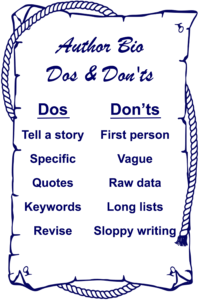 At the top of the list of essential elements of an author website you’ll find the About page. This section consists of the author bio, the long version. Yes, your author bio needs more than one incarnation. Joan Stewart “The Publicity Hound” recommends four bios.
At the top of the list of essential elements of an author website you’ll find the About page. This section consists of the author bio, the long version. Yes, your author bio needs more than one incarnation. Joan Stewart “The Publicity Hound” recommends four bios.
Here’s what I instruct my clients to create for their bios:
- 20 words or less to use as a tagline after your name, like on LinkedIn or in your email signature
- 100-150 words to include if you submit an article to somebody else’s website, a teaser for your own homepage, for your speaker one-sheet.
- 200-250 words to advertise your book signings or personal appearances, to post on your social media profiles
- 300-400 words go on your author website About page
Start by composing the long version then chop, chop, chop, killing your darlings. I’m sure most of us writers have experience cutting down a story or article to fit a certain word length.
The short-short, tagline, bio boils everything down to the essence of who you are and what you do. Think of this as your mission statement.
What’s the Purpose?
Do you think your author bio exists to give people information about you? Sorry, but no. The reason for your author bio is to make people know, like and trust you. Once people see who you are, as a real person, they’ll want to buy your books and hear you speak. Remember, your author bio is not a scientific article packed full of raw data.
Getting Started
Approach writing your author bio like writing a story with you as the main character. If you’re a fiction writer you’re familiar with character profile questionnaires. Try filling one of those out for yourself.
Fiction writers also know that good storytelling techniques involve the main character changing. Make a list of events in your life that caused you to change in some way. Study that list. The event might not make it into your author bio but you might use something associated with it to help your story come to life.
Ever attended a group where the icebreaker consisted of stating a fact about yourself nobody else in the room can claim? Get a jump on this activity by brainstorming now. Jot down five facts about yourself not many people share. What makes you unique will elevate your bio above those of other authors.
Best Practices
Every reader loves a good story so, like I said above, try to make your author bio read like a story with you as the main character. Exercise your skills as a writer. For instance, don’t forget to use specifics. If you mention your first car make sure to specify the make and model or if you mention your garden specify the flowers or vegetables you grow.
Need more material? Brag about the organizations you volunteered for and the people you associate with. Who are your mentors and heroes? Use a quote from somebody you respect. Or quote yourself.
Think about the audience you want to attract. Who do you want to buy your books? Make your author bio relevant to your writing and show your readers why you developed the interests you write about. Connecting with the people you sell your books to is the main purpose of your author bio.
Humans aren’t your only consideration. The long bio that lives on the About page of your author website needs to involve keywords and phrases to entice search engine bots in order to attract more traffic to your site.
Worst Practices
My background includes editing newsletters and producing monthly speaker meetings. Each time I opened the bio the presenters sent I crossed my fingers. I groaned if I saw only a CV or resume, or a 1,000 word bio written in 😜 first person. Please write your bio in third person.
Like with anything you write avoid passive voice and dull sentence construction. Put your best writers foot forward to make your bio as good as anything you’ve ever written.
Of course you want to include your education, experience, awards, and publications, but please no long laundry lists. Try to create interesting sentences around those details. When possible explain why that accomplishment happened or changed your life.
Watch out for words that make the writing vague, such as things, activities, challenges, risks, people, and worst of all it. Replace these types of words with concrete phrases.
Last Piece of Advice
Treat your author bio like any story or article you send out. Proof read and edit, ask others to go over your bio as well.
Now that I’ve written this article I realize I need to go back to my bio to perform some revisions, take my own advice. If you already have an author bio you wrote a while ago, look it over and see if you need a new edition.
These tips were really helpful to me as I wrote my four bios, especially the advice to start with the longest. Thanks, Ninety Degrees!
Thank you, Lisa Angle, for sharing this invaluable information.